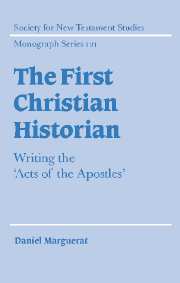Book contents
- Frontmatter
- Contents
- Preface
- 1 How Luke wrote history
- 2 A narrative of beginnings
- 3 The unity of Luke–Acts: the task of reading
- 4 A Christianity between Jerusalem and Rome
- 5 The God of Acts
- 6 The work of the Spirit
- 7 Jews and Christians in conflict
- 8 Ananias and Sapphira (Acts 5. 1–11): the original sin
- 9 Saul's conversion (Acts 9; 22; 26)
- 10 The enigma of the end of Acts (28. 16–31)
- 11 Travels and travellers
- Bibliography
- Index of passages
2 - A narrative of beginnings
Published online by Cambridge University Press: 22 September 2009
- Frontmatter
- Contents
- Preface
- 1 How Luke wrote history
- 2 A narrative of beginnings
- 3 The unity of Luke–Acts: the task of reading
- 4 A Christianity between Jerusalem and Rome
- 5 The God of Acts
- 6 The work of the Spirit
- 7 Jews and Christians in conflict
- 8 Ananias and Sapphira (Acts 5. 1–11): the original sin
- 9 Saul's conversion (Acts 9; 22; 26)
- 10 The enigma of the end of Acts (28. 16–31)
- 11 Travels and travellers
- Bibliography
- Index of passages
Summary
What can be said about the aim of the book of Acts? Why did Luke write a follow-up to his gospel? What was his goal and what pushed him to write this grand historical work? I shall deal with these questions in two ways. First, it is important to know what the book of Acts resembles in the world of ancient literature. To what literary genre does it belong? Second, the relevance of the narrator's point of view, or his narrative intention must be considered. I shall conclude by evaluating Luke's decision to add the Acts of the Apostles to the gospel.
Seeking a literary genre
In today's context, the affiliation of the gospels with the Graeco-Roman literary genre of biography (the affinity of the gospel of Luke with the Lives of the philosophers is evident) provokes no great difficulties. On the contrary, exegetes continue to have a hard time classifying the second part of the work ad Theophilum. Many suggestions have been made in an attempt to identify the literary genre of Acts, but the absence of any satisfying analogy in ancient literature makes the decision arduous.
A continuation of the gospel?
Charles Talbert has proposed that one view of the Luke–Acts succession is the Life of a philosopher followed by the story of his disciples. Hence, the biography of the founder of the religious movement should be followed by the story of his successors.
- Type
- Chapter
- Information
- The First Christian HistorianWriting the 'Acts of the Apostles', pp. 26 - 42Publisher: Cambridge University PressPrint publication year: 2002



